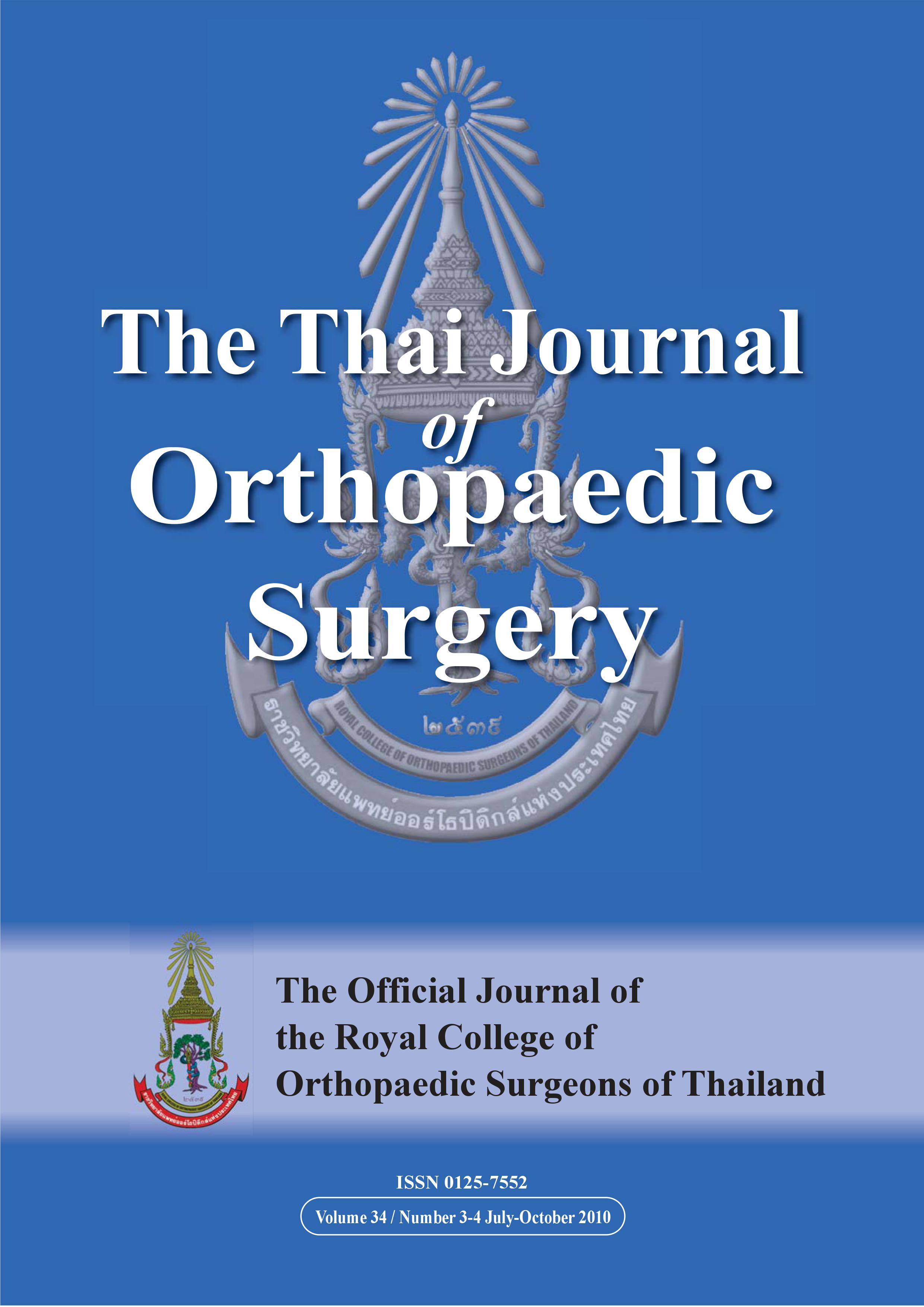Mortality and ambulatory status after intertrochanteric fracture treated at Maharat Nakhon Ratchasima Hospital, Thailand
Main Article Content
Abstract
Purpose: 1. To assess elderly intertrochanteric fracture patients for overall one-year mortality rate and for ambulatory ability two years after treatment.
- To analyze factors that may affect one-year mortality and independent walking.
- To compare one-year mortality, survival function, and independent walking between operative and home skin traction treatment.
Methods: A retrospective cohort study of 496 intertrochanteric fracture patients at least 60 years of age, treated at Maharat Nakhon Ratchasima Hospital between October 2002 and September 2006, assessed one-year mortality rate and two-year ambulatory ability. The factors studied were treatment methods (251 operation, 245 home skin traction), gender (337 female, 159 male), age (mean 78 years, SD8.7), numbers of comorbidities (57% had one or more comorbidities), and ASA classification (ASA I, II, III, and IV were 55%, 36.7%, 7.5%, and 0.8% respectively).
Results: The overall one-year mortality rate was 23.6%. The median survival time was 4.18 years after fracture. Of patients who were still alive two years later, 55.2% could walk independently, 27.7% needed assistance or gait aids, and 17.1% were confined to bed or wheelchair. Factors that significantly affected one-year mortality were nonoperative treatment, being male, and each additional year of age. The home traction group had a higher one-year mortality rate than the operative group (odds ratio 3.01; 95 % CI 1.8634, 4.8997 P 0.000). Independent walking depended on type of treatment only. The operative group had more independent walking (odds ratio 2.19; 95% CI 1.3009, 3.6917 P 0.003). Gender, age, numbers of comorbidities, and ASA class did not affect independent walking.
Conclusion: Intertrochanteric fracture in the elderly is a terrible condition with a very high risk of one-year mortality and later dependence. Operative internal fixation is the treatment of choice, with a lower one-year mortality rate and more independent walking.
Article Details
References
2. Gong MQ, Mao YJ, Wei J, Wang MY, Bai J, Fan QL, et al. Outcome of hip fractures after traction treatment in elderly. Zhonghua Yi Xue Za Zhi. 2005; 85(46): 3263-5.
3. Kazakos K, Lyras DN, Verettas D, Galanis V, Psillakis I, Xarchas K. External fixation of intertrochanteric fractures in elderly high risk patients. Acta Orthop Belg. 2007; 73(1): 44-8
4. Hornby R, Evans JG, Vardon V. Operative or conservative treatment for trochanteric fracture of the femur. A randomized epidemiological trial in elderly patients. J Bone Joint Surg Br. 1989; 71(4): 619-23.
5. Handoll HH, Parker MJ, Bhargava A. Conservative versus operative treatment for hip fractures in adults. The Cochrane Library. 2007(4).
6. Dzupa V, Bartonicek J, Skala-Rosenbaum J, Prikazsky V. Mortality in patients with proximal femoral fractures during the first year after the injury. Acta Chir Orthop Traumatol Cech. 2002; 69(1): 39-44.
7. Chariyalertsak S, Suriwongpisal P, Thakkinstain A. Mortality after hip fractures in Thailand. Int Orthop. 2001; 25: 294-7.
8. Rojanasthien S, Luevitoonvechkij S. Epidemiology of hip fracture in Chiang Mai. J Med Assoc Thai. 2005; 88(5): 105-9.
9. Chapman MW. Fractures of the hip and proximal femur. In: Chapman MW, editor. Chapman’s orthopaedic surgery. 3rd ed. Philadelphia: Lippincott Williams Wilkins; 2001: p. 634-50.
10. Hommel A, Ulander K, Bjorkelund KB, Norrman PO, Wingstrand H, Thorngren KG. Influence of optimised treatment of people with hip fracture on time to operation, length of hospital stay, reoperations and mortality within 1 year. Injury. 2008; 39(10): 1164-74.
11. Ooi LH, Wong TH, Toh CL, Wong HP. Hip fractures in nonagenarians: A study on operative and nonoperative management. Injury. 2005; 36(1): 142- 7.
12. Bong SC, Lau HK, Leong JC, Fang D, Lau MT. The treatment of unstable intertrochanteric fractures of the hip: A prospective trial of 150 cases. Injury. 1981; 13(2): 139-46.
13. Jain R, Basinski A, Kreder HJ. Nonoperative treatment of hip fractures. Int Orthop. 2003; 27(1): 11-7.
14. Ishida Y, Kawai S, Taguchi T. Factors Affecting Ambulatory Status and Survival of Patients 90 Years and Older with Hip Fractures. Clin Orthop Relat Res. 2005(436): 208-15.
15. Kitamura S, Hasegawa Y, Suzuki S, Sasaki R, Iwata H, Wingstrand H, et al. Functional outcome after hip fracture in Japan. Clin Orthop Relat Res. 1998(348): 29-36.
16. Ingemarsson AH, Frändin K, Mellström D, Möller M. Walking ability and activity level after hip fracture in the elderly: A follow up. J Rehabil Med. 2003; 35(2): 76-83.
17. Richmond J, Aharonoff GB, Zuckerman JD, Koval KJ. Mortality risk after hip fracture. J Orthop Trauma. 2003; 17(1): 53-6.


